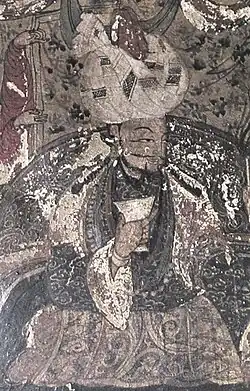Tashi Namgyal I
| Tashi Namgyal | |
|---|---|
| Gyalpo of Ladakh | |
 | |
| Reign | c. 1555 – 1575 |
| Predecessor | Lhawang Namgyal |
| Successor | Tsewang Namgyal I |
| House | Namgyal dynasty |
| Religion | Tibetan Buddhism |
Tashi Namgyal (reigned c. 1555 – 1575) was a ruler of the Namgyal dynasty of Ladakh. He is known for strengthening the kingdom’s defences and for repelling incursions by Central Asian raiders.[1][2]
See also
Reign
The king is credited with:
- Repelling raids from Central Asia.
- Consolidating control over areas such as Kargil and parts of Guge.
- Strengthening fortifications in Leh, notably the Namgyal Tsemo fort and monastery.[2]
- Supporting Buddhist monastic establishments.
Architecture
Tashi Namgyal founded or restored the Namgyal Tsemo Monastery above Leh, a strategic fort and temple complex which still stands today.[2] He is also associated with the expansion of Phyang Monastery.
Succession
Having no direct heirs, he arranged for his brother's marriage, and his nephew Tsewang Namgyal I succeeded him after his death around 1575.[3]
Legacy
Historians regard Tashi Namgyal as a capable ruler who combined military leadership with cultural patronage. His constructions remain important heritage sites in modern Ladakh.
References
- Petech, Luciano. The Kingdom of Ladakh, c. 950–1842 A.D.. Rome: Istituto Italiano per il Medio ed Estremo Oriente, 1977 .
- Rizvi, Janet. Ladakh: Crossroads of High Asia. Delhi: Oxford University Press, 1996.
- Jina, Prem Singh. History of Ladakh: Study of Namgyal Dynasty. Delhi: Rajat Publications, 2014. ISBN 8178806339.
- ^ Petech, Luciano (1977). The Kingdom of Ladakh, c. 950–1842 A.D. Rome: Istituto Italiano per il Medio ed Estremo Oriente.
- ^ a b c Rizvi, Janet (1996). Ladakh: Crossroads of High Asia. Delhi: Oxford University Press.
- ^ Cite error: The named reference
namgyal_dynastywas invoked but never defined (see the help page).